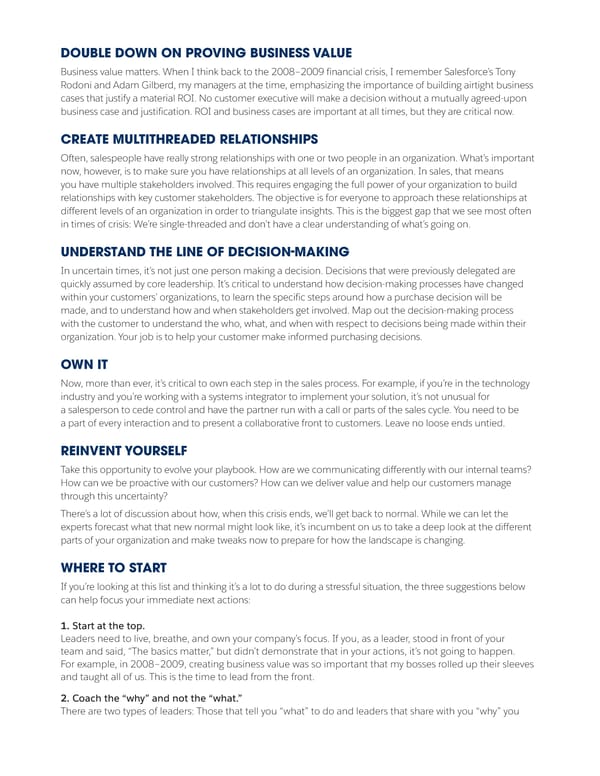DOUBLE DOWN ON PROVING BUSINESS VALUE Business value matters. When I think back to the 2008–2009 financial crisis, I remember Salesforce’s Tony Rodoni and Adam Gilberd, my managers at the time, emphasizing the importance of building airtight business cases that justify a material ROI. No customer executive will make a decision without a mutually agreed-upon business case and justification. ROI and business cases are important at all times, but they are critical now. CREATE MULTITHREADED RELATIONSHIPS Often, salespeople have really strong relationships with one or two people in an organization. What’s important now, however, is to make sure you have relationships at all levels of an organization. In sales, that means you have multiple stakeholders involved. This requires engaging the full power of your organization to build relationships with key customer stakeholders. The objective is for everyone to approach these relationships at different levels of an organization in order to triangulate insights. This is the biggest gap that we see most often in times of crisis: We’re single-threaded and don’t have a clear understanding of what’s going on. UNDERSTAND THE LINE OF DECISION-MAKING In uncertain times, it’s not just one person making a decision. Decisions that were previously delegated are quickly assumed by core leadership. It’s critical to understand how decision-making processes have changed within your customers’ organizations, to learn the specific steps around how a purchase decision will be made, and to understand how and when stakeholders get involved. Map out the decision-making process with the customer to understand the who, what, and when with respect to decisions being made within their organization. Your job is to help your customer make informed purchasing decisions. OWN IT Now, more than ever, it’s critical to own each step in the sales process. For example, if you’re in the technology industry and you’re working with a systems integrator to implement your solution, it’s not unusual for a salesperson to cede control and have the partner run with a call or parts of the sales cycle. You need to be a part of every interaction and to present a collaborative front to customers. Leave no loose ends untied. REINVENT YOURSELF Take this opportunity to evolve your playbook. How are we communicating differently with our internal teams? How can we be proactive with our customers? How can we deliver value and help our customers manage through this uncertainty? There’s a lot of discussion about how, when this crisis ends, we’ll get back to normal. While we can let the experts forecast what that new normal might look like, it’s incumbent on us to take a deep look at the different parts of your organization and make tweaks now to prepare for how the landscape is changing. WHERE TO START If you’re looking at this list and thinking it’s a lot to do during a stressful situation, the three suggestions below can help focus your immediate next actions: 1. Start at the top. Leaders need to live, breathe, and own your company’s focus. If you, as a leader, stood in front of your team and said, “The basics matter,” but didn’t demonstrate that in your actions, it’s not going to happen. For example, in 2008–2009, creating business value was so important that my bosses rolled up their sleeves and taught all of us. This is the time to lead from the front. 2. Coach the “why” and not the “what.” There are two types of leaders: Those that tell you “what” to do and leaders that share with you “why” you
 Selling and Engaging Customers in Uncertain Times Page 1 Page 3
Selling and Engaging Customers in Uncertain Times Page 1 Page 3